MP Board Solutions for Class 10 Science Chapter 3 – Metals and Non-metals
MP Board Solutions for Class 10 Science Chapter 3 – Metals and Non-metals are essential for understanding key Chemistry concepts in the MPBSE curriculum. These well-structured answers help students grasp topics like physical and chemical properties of metals and non-metals, reactivity series, and corrosion. Designed as per the latest syllabus, these solutions strengthen conceptual clarity and improve exam preparation. Ideal for revision and practice, they encourage logical thinking and scientific understanding, making them a valuable study tool for scoring well in Class 10 Science exams.
MP Board Solutions For Class 10 Science – Metals and Non-Metals – Exercise Images
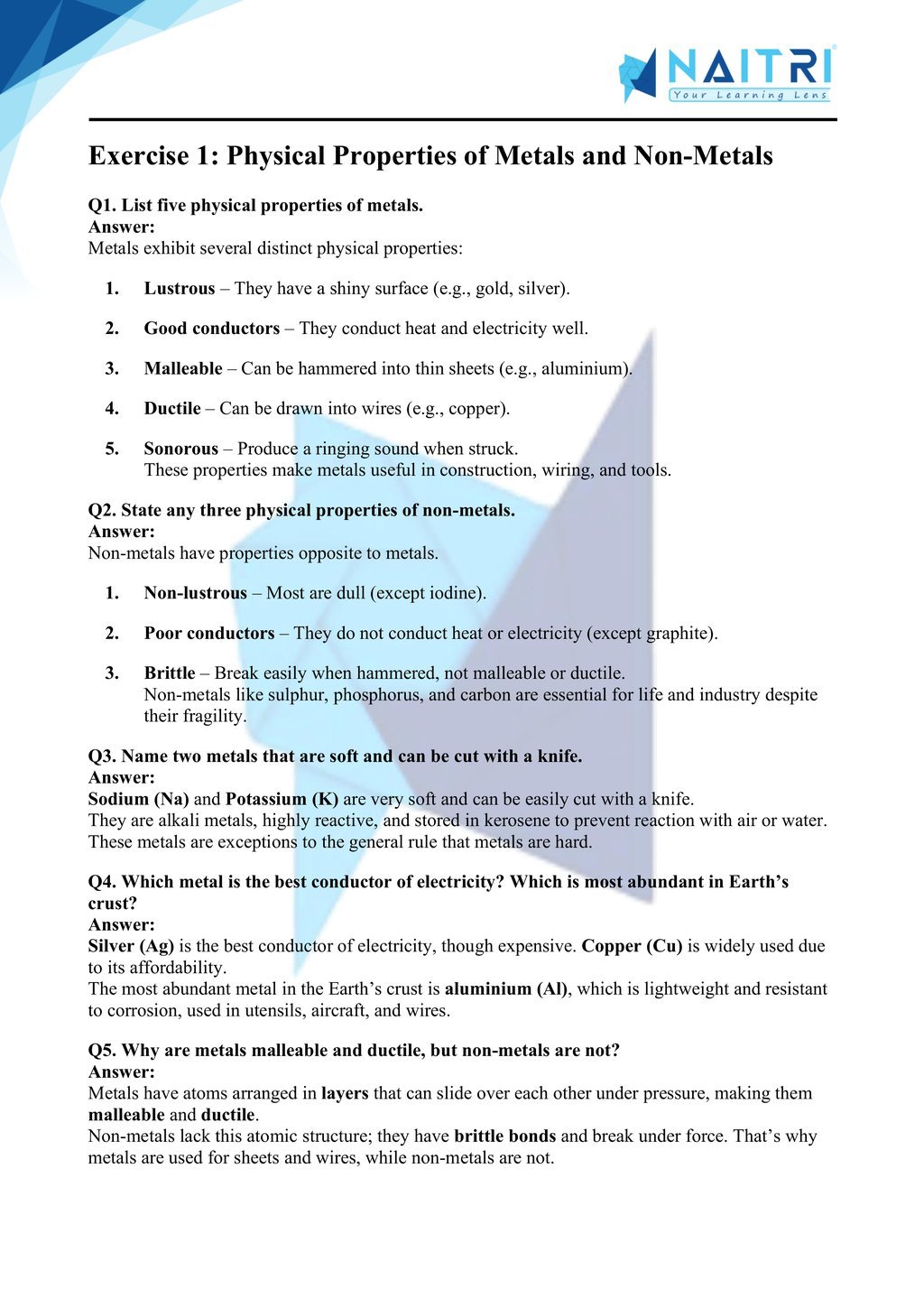
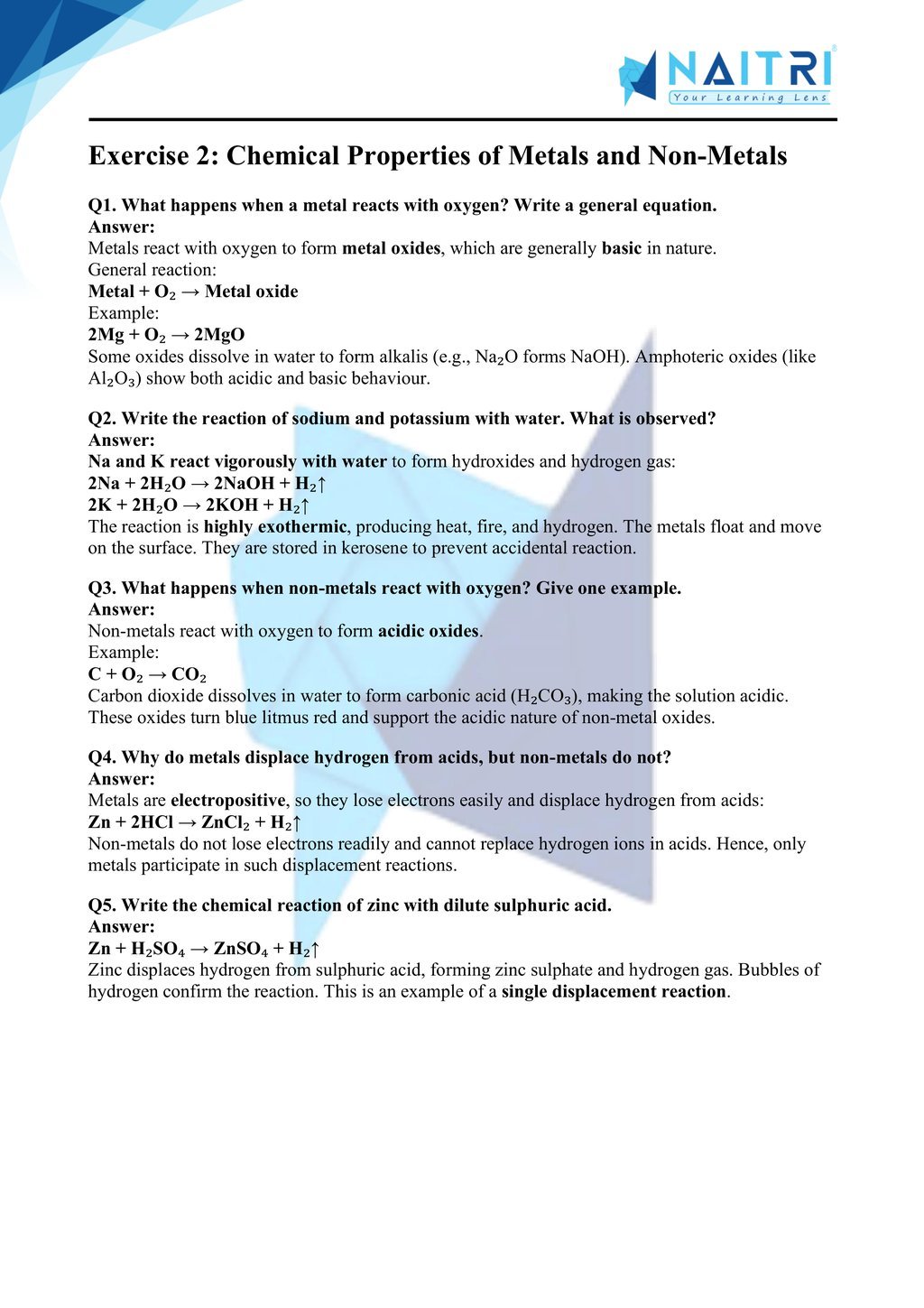
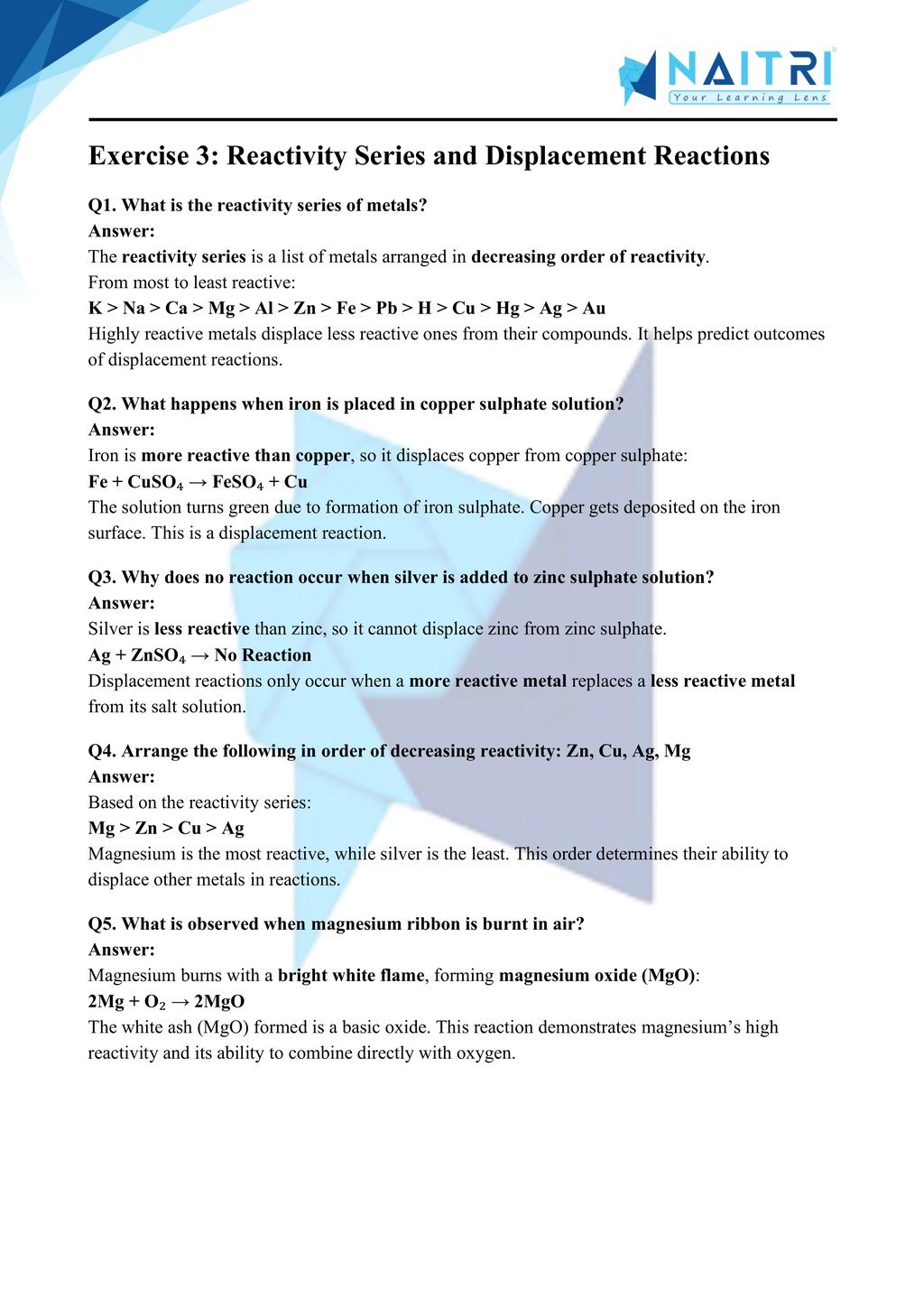
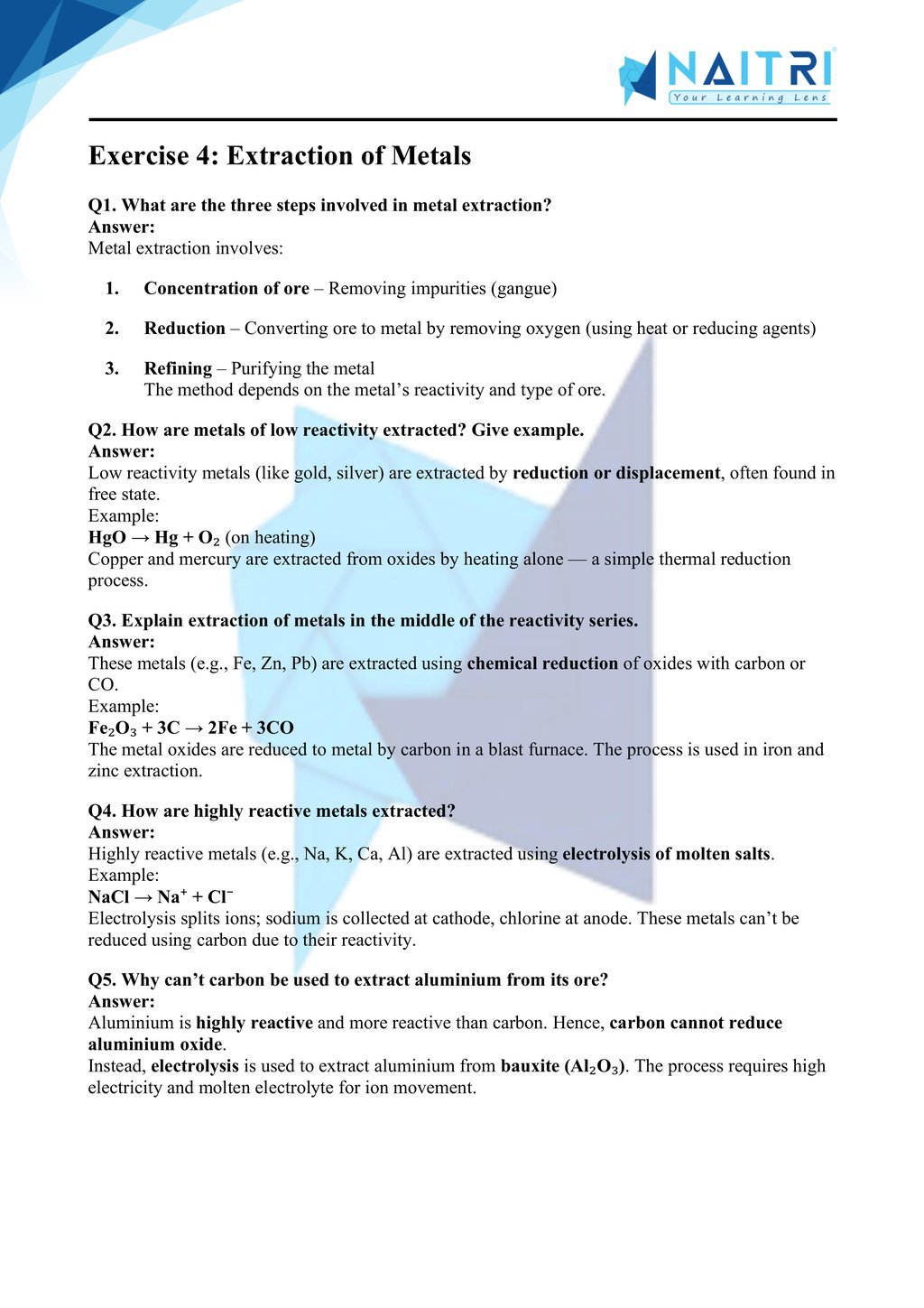
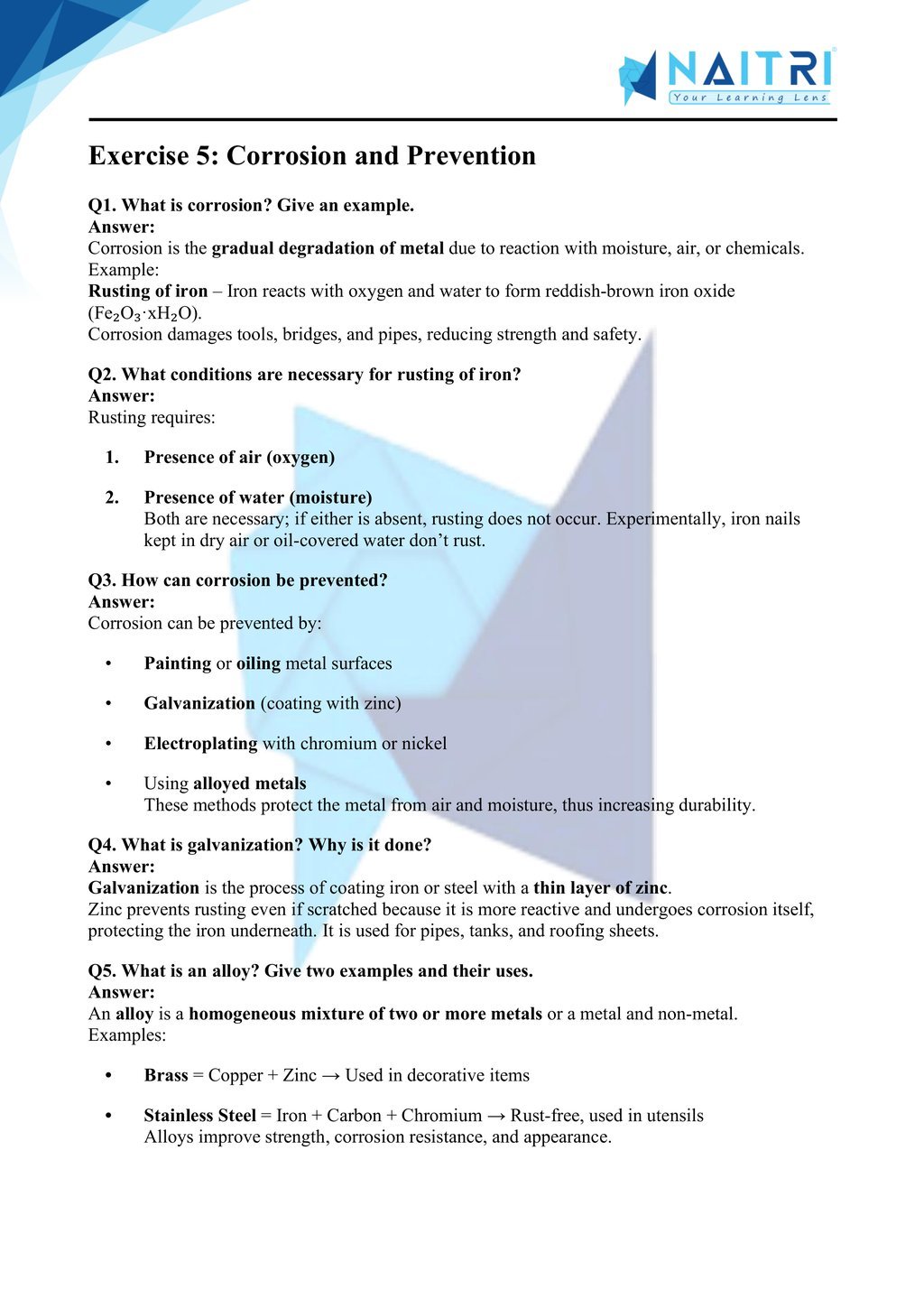
Experience Science Like Never Before – With AR!
Understanding Metals and Non-metals is now more exciting and immersive! With the NAITRI App, you can explore complex science concepts through Augmented Reality (AR). Watch metals react, properties compare, and extraction processes unfold — right in front of you. Our AR-powered lessons make learning interactive, 3D, and fun, helping you retain concepts better and enjoy every topic.



Visualize . Interact . Understand . The future of learning is here
Metals and Non‑metals – Important Questions with Answers
1. What is the definition of a metal? Give two examples.
Answer: A metal is a substance that is typically malleable, ductile, lustrous, and a good conductor of heat and electricity. Examples include iron (Fe) and copper (Cu), commonly used in construction and electrical wiring respectively.
2. What is a non‑metal? Provide two examples.
Answer: A non‑metal is an element lacking metallic properties, usually brittle, non‑lustrous, and poor conductors of heat and electricity. Examples include sulfur (S), used in matches, and chlorine (Cl), utilized in water purification.
3. List five physical properties of metals.
Answer: Metals generally have a shiny lustre, are malleable (formed into sheets), ductile (drawn into wires), good conductors of heat and electricity, and have high density and melting points due to metallic bonding.
4. List five physical properties of non‑metals.
Answer: Non‑metals exhibit dull appearance, are generally brittle, non‑malleable, poor conductors of heat and electricity, and may exist in solid, liquid (e.g., bromine), or gaseous (e.g., nitrogen) states.
5. Explain why metals are good conductors of electricity and heat.
Answer: Metals contain mobile electrons in their lattice structure that can move freely. This free electron movement allows efficient transfer of thermal energy and electrical current through the metallic bonds.
6. Explain why non‑metals are poor conductors of electricity and heat.
Answer: Non‑metals lack mobile electrons and often have covalent bonds that hold electrons tightly. This restricts electron movement, making them inefficient at conducting electricity and heat compared to metals.
7. Describe the chemical reactivity of metals with water, providing two distinct examples.
Answer: Some metals like sodium react violently with water to produce hydroxides and hydrogen gas, whereas metals like iron react slowly. Example: 2Na + 2H₂O → 2NaOH + H₂; Fe + H₂O → FeO + H₂ (on heating).
8. Describe the chemical reaction of non‑metals with oxygen, giving two examples.
Answer: Non‑metals typically form acidic or neutral oxides when reacting with oxygen. For example, sulfur dioxide (SO₂) forms when sulfur burns in oxygen; nitrogen dioxide (NO₂) forms during high-temperature combustion in car engines.
9. What is a displacement reaction between metals? Give an example.
Answer: A displacement reaction occurs when a more reactive metal replaces a less reactive metal from its compound. For instance, zinc reacts with copper sulfate to produce zinc sulfate and copper metal.
10. What is an oxidation reaction in metals? Provide an example.
Answer: Oxidation in metals involves loss of electrons during reaction with oxygen or other substances. Example: Magnesium reacts vigorously with oxygen to form magnesium oxide, a white powder.
11. Define the term ‘rusting’ and state its chemical formula.
Answer: Rusting is the corrosion of iron in presence of oxygen and water, producing hydrated iron(III) oxide, commonly written as Fe₂O₃·xH₂O.
Balanced reaction: 4Fe + 3O₂ + xH₂O → 2Fe₂O₃·xH₂O.
12. List three methods to prevent rusting and explain how one method works.
Answer: Preventive methods include painting, galvanizing with zinc coating, and alloying. Galvanization works by forming a protective zinc layer that corrodes in preference to the underlying iron.
13. What properties of metals make them suitable for making electrical wires?
Answer: High conductivity, malleability, and ductility make metals like copper ideal for wiring. They easily carry electric charge and can be drawn into thin wires without breaking.
14. Define an amphoteric oxide, giving one example.
Answer: Amphoteric oxides react with both acids and bases. For instance, aluminum oxide reacts with hydrochloric acid to form aluminum chloride and with sodium hydroxide to form sodium aluminate.
15. Why is aluminum oxide amphoteric in nature?
Answer: Aluminum oxide contains both acidic (Al³⁺) and basic (O²⁻) ions, enabling it to react with acids and bases. Example: Al₂O₃ + 6HCl → 2AlCl₃ + 3H₂O and Al₂O₃ + 2NaOH + 3H₂O → 2NaAl(OH)₄.
16. Compare the reactivity of metals like sodium and gold.
Answer: Sodium is a highly reactive alkali metal, reacting vigorously with water and oxygen, while gold is very inert, resisting corrosion and oxidation in air and water, even over long periods.
17. Explain why metals are malleable and ductile at the atomic level.
Answer: Metallic bonding creates a lattice of positive ions surrounded by a sea of delocalized electrons, allowing ions to slide past each other under stress without breaking bonds, hence enabling malleability and ductility.
18. Why do non‑metallic elements like carbon exist in different allotropes?
Answer: Carbon exhibits allotropy, meaning it can form different structural arrangements like graphite and diamond due to versatile bonding patterns. This ability arises from its small size and valency.
19. Name two metals that cannot be found free in nature and explain why.
Answer: Metals like sodium and iron cannot be found free because they are very reactive and chemically combine with other elements to form compounds such as salts and oxides.
20. Name two metals that occur in nature in native form and explain their resilience.
Answer: Gold and platinum exist naturally in pure form. They resist oxidation and corrosion due to their low chemical reactivity, maintaining metallic state despite environmental exposure.
21. Why does ionic compound sodium chloride have a high melting point?
Answer: In sodium chloride, strong electrostatic forces between Na⁺ and Cl⁻ ions within the ionic lattice require considerable energy to break, resulting in a high melting point.
22. Explain the process of extraction of a metal from its oxide using carbon.
Answer: Metals like zinc and copper can be extracted via reduction by carbon. For example, carbon monoxide reduces metal oxides at high temperatures: ZnO + C → Zn + CO.
23. Why are transition metals like iron and copper important in industry?
Answer: Transition metals have variable oxidation states, form alloys, and resist corrosion in some forms. Their ductility and conductivity make them essential for electrical components, machinery, infrastructure, and coinage.
24. Describe how rust formation is a redox reaction.
Answer: In rusting, iron is oxidized (loses electrons to oxygen), and oxygen is reduced (gains electrons from iron). This simultaneous oxidation‑reduction process results in hydrated iron oxide formation.
25. Explain why metals generally form basic oxides and non‑metals form acidic oxides, citing exceptions.
Answer: Metal oxides, containing metal ions and O²⁻ ions, typically form alkaline solutions in water. Non‑metal oxides contain acidic elements and, when dissolved in water, often produce acids like CO₂ forming carbonic acid. Al₂O₃ is an amphoteric exception.
Metals and Non-metals compares the properties of these two major types of elements. The chapter explains physical and chemical properties, reactivity, and how metals are extracted and used. Concepts such as corrosion, displacement reactions, and the uses of metals in tools and wiring help students understand how materials are selected and used in construction, electronics, and industry.
Related Chapters You May Like
Download Naitri App
Easy, Visual Learning — Right on Your Phone
Learn with Augmented Reality! The Naitri app makes CBSE and MP Board concepts interactive and fun — even in low-resource settings. Watch lessons, complete homework, take tests, and track progress — all in one place. Anytime. Anywhere.
Available on








